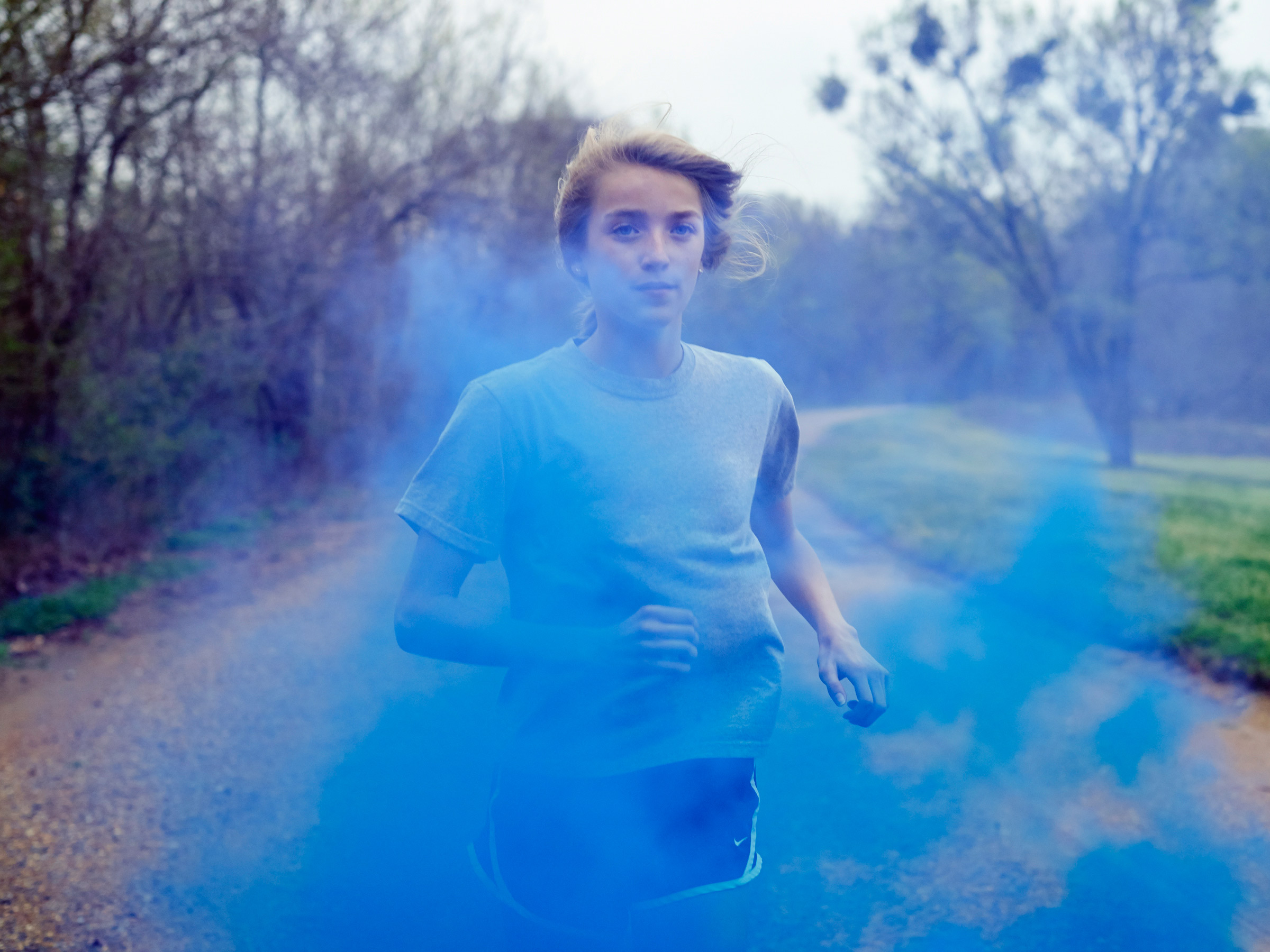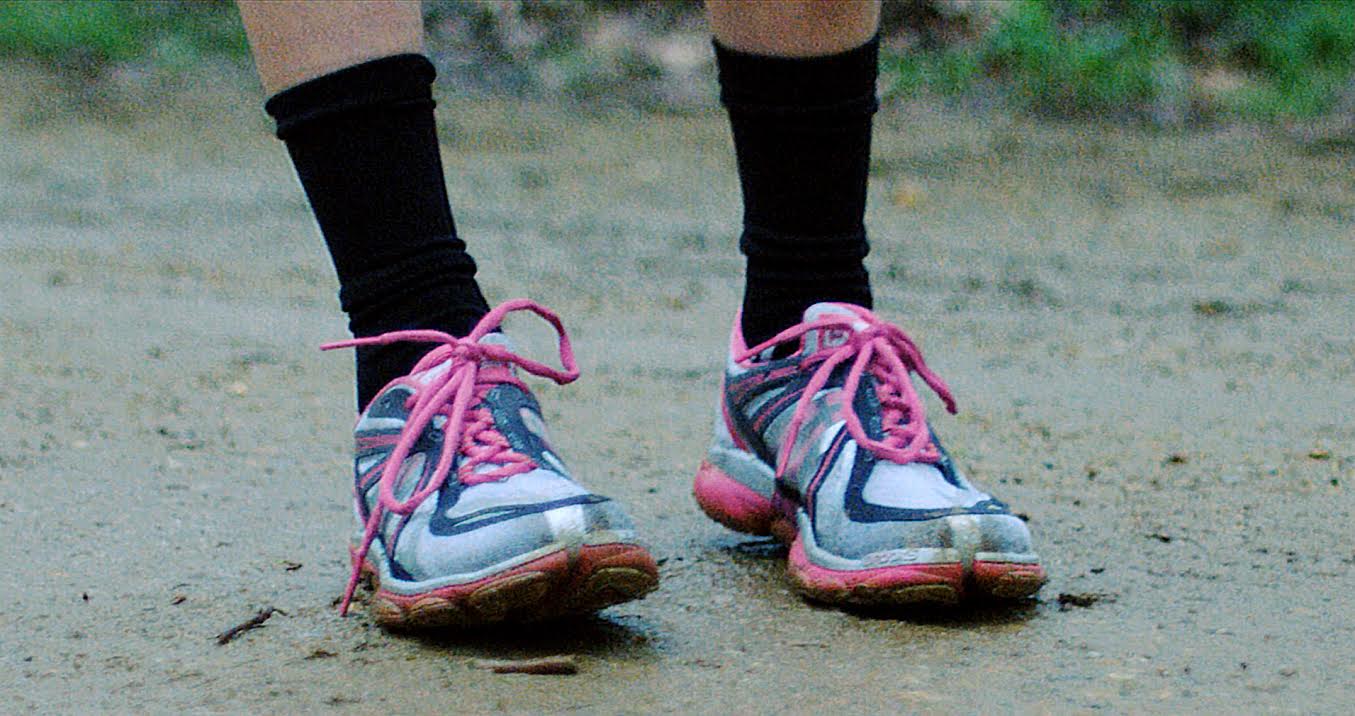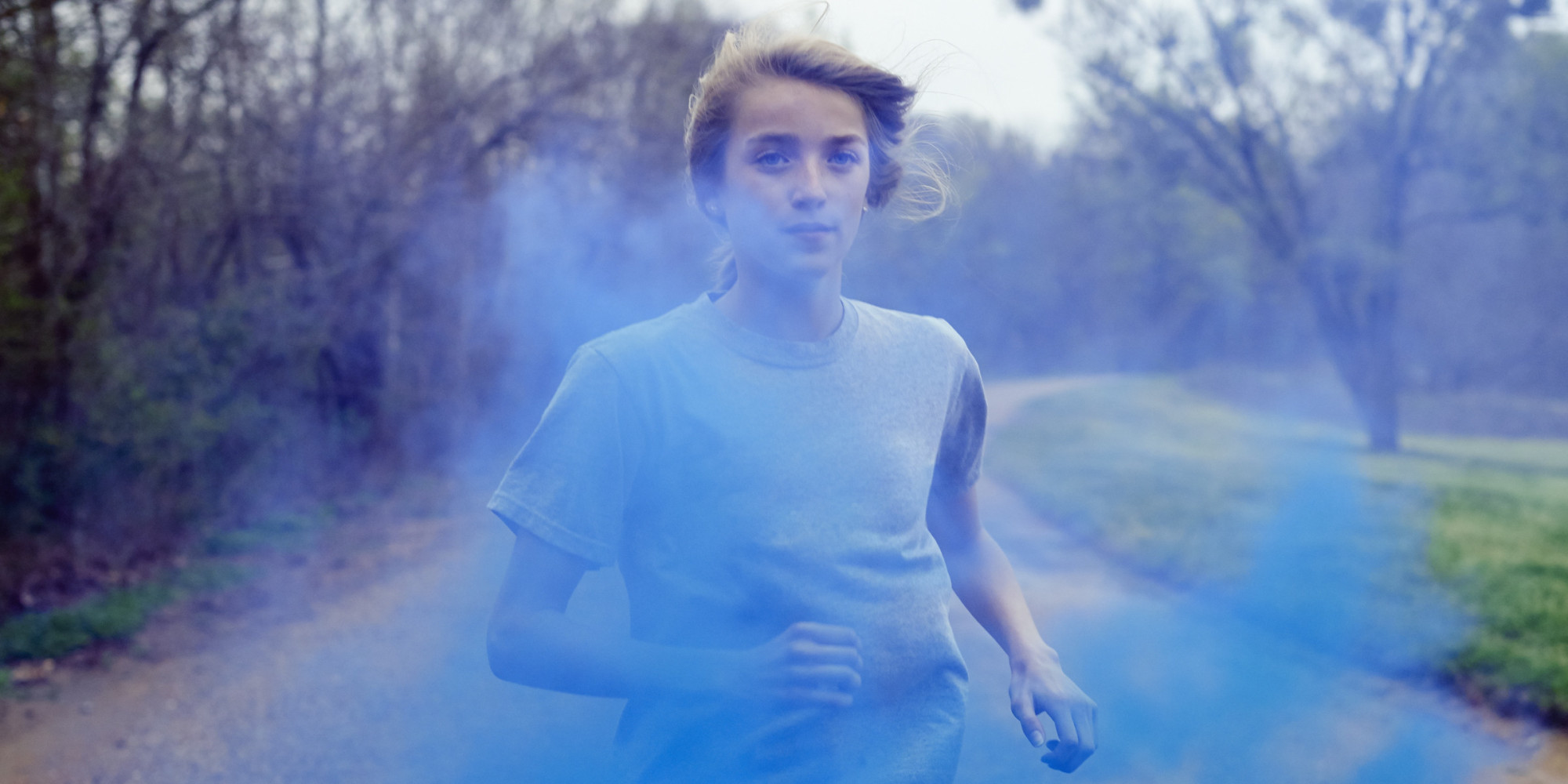The course was swampy in the low parts, but the sky was clear and the November weather fair enough for running fast. Which is exactly what Jordan van Druff was doing. The muscular eighth-grader had opened up a long lead against the best 13- and 14-year old distance runners in the South. He descended the final hill of the five-kilometer race carefully, picking his way among the rocks and roots until he reached the bottom and turned for home through a gauntlet of shouting fans and coaches. He was in complete command, and yet he looked afraid.
Behind him, flying down the hill as if there were no rocks or roots at all, emerged a figure with long, wild blond hair. This runner accelerated, eyes on Jordan’s back as if he were dinner.
“That’s a girl. That’s a girl,” said one of the coaches. People pressed against the restraining barrier to catch sight of her.
Her name was Amaris Tyynismaa. She was 13 years old and lithe, dressed in bright pink and orange. With each step, she took big bites of ground, and her strides seemed to get longer and easier the faster she ran. Strangest of all, she was smiling, though distance running is first and foremost an exercise in agony. Several of the boys she passed cheered her on.
Had the race been 200 meters longer, she might have won the whole thing. When she did cross the line, twelve seconds behind Jordan and solidly in front of everyone else, she looked over at the clock: 3.1 miles in 16:57. It was one of the fastest times in the country among high school girls last year—except Amaris was still in middle school. In fact, she had only started running competitively the year before.
By the time of this race—the Foot Locker South Regional in Charlotte last fall—Amaris had already captured an Alabama high school cross-country championship by 80 seconds, the equivalent of winning a basketball game by 100. In February, after setting a few more Alabama state records, she was named an All-American in indoor distance running, the only middle-schooler of the bunch.
Her coaches believe she has the talent to be an NCAA champion, maybe even an Olympian. They say this cautiously, fully aware that such talk about a runner so young is risky. Ankles and shins break down, motivation fades, the body transforms. These are the challenges that confront every racer who shows early promise. Amaris, though, has others to contend with.
The day before the race in Charlotte, her father, Mike, an Air Force pilot, picked her up as if she were a little girl and carried her up 17 flights of stairs because she was too terrified to get inside the elevator at their hotel. All closed spaces paralyze her with anxiety and fear: her face goes flush, her heart races, her whole body becomes hot. The first time she encountered the hotel elevator, she took the stairs and wore herself out. The second time, her father wouldn’t let her exhaust herself before the race. As he climbed, he held her close while she cracked jokes and tried to get her heart to slow down.
A couple months later, Amaris’ mother, Kristen, explained how someone so unnaturally talented could also be so fragile. Kristen is perceptive and protective of her children, and she’s had plenty of reason to think about the struggle between Amaris’ body and brain. “When she runs,” Kristen says, “I think she’s running from disorder.”
When Amaris was three years old, her parents would sometimes find her lying on the floor, face up and stiff, the muscles in her body clenched all at once. Her eyes would be wide open and focused to one side; her face would be red from holding her breath. Then, after a few minutes, she’d get up and continue playing as if nothing had happened.
Other times, she’d prove overly sensitive to the feeling of certain fabrics and textures on her skin. She would put on a coat to go outside and fall down crying and kicking. What followed were years of consultations, tests, and different kinds of therapies. Whenever doctors seemed close to an answer, the demands of military life would cause the family to move, and the process would start all over again. Finally, after a year of dedicated observation, a doctor at Walter Reed diagnosed her with Tourette syndrome, or TS.
Despite the widespread, pop-cultural representation of TS as a swearing disease, Amaris, like 90 percent of people with Tourette’s, never cusses or uncontrollably shouts offensive things. (Omigosh is as close as she comes to bad language.) Instead, she experiences irresistible urges to move parts of her body in very specific motions, and sometimes to make little noises in her throat—to tic, as it’s called, although the word seems too minor. A few years ago, the tics were so overwhelming they would jolt her right out of her desk. She spent so much energy fighting them that she couldn’t concentrate in school; she knew the other kids thought she was stupid. “It’s like a little evil person on your shoulder and they’re telling you to do stuff, and you have to try to fight them,” she says.
There are kids who are Youth Ambassadors for the Tourette Syndrome Association, and kids who write for its newsletter, That Darn Tic. Amaris is not that sort of kid. She hates the tics, and she especially hates the idea that people think she should accept them. The way she sees it, they attacked her.
Sleep disturbances are common among people with TS, and hers—night terrors which began around kindergarten and continued for several years—were unforgiving. Every night, 45 minutes after falling asleep, her parents would hear her leap to the floor from her bed. She’d run around the house, up and down the stairs, screaming. She would see airplanes flying, diving, maybe crashing. Sometimes she was in them and sometimes they were circling in the air above her. She would feel terrified and alone. And she would experience actual physical pain, an inextinguishable burning, in her thumb. After a while, she would calm down, go back to bed, and barely remember the details in the morning.
“It’s very sad to see your child in so much pain,” Kristen says, “especially when it's so uncharacteristic of who she is, this confident and amazing girl. But then she has this other part of her.” And that part compelled her to hide. In the fourth grade Amaris began carrying a rock to rub and a bag of sweet-smelling herbs to squeeze when she felt the tics come on. It helped a little. Like other TS kids, she also developed secret techniques to seem more like everyone else.
“I used to feel the urge to spread my legs apart like a stretch,” Amaris says, “and I remember this one time I was in line walking and I had to do it, I just had to, and so I pretended to stretch and did jumping jacks a little bit, and yeah. No one said anything.”
She couldn’t wait to be by herself in the hallway, or for moments in class when no one was looking. Only then could she pop her hip out over and over again, or stretch her mouth as wide as it could go, or jerk her neck to the side so hard it would cause her both pain and relief. Most of the time, though, she had to put on her best behavior and store her tics for later. By the end of the school day, she’d be beat.
“I would get in my mom’s car and just be so exhausted and upset, and I guess upset at myself, that I would just yell,” Amaris says. “I’d throw a tantrum. I’d do all the tics. I’d cry. Omigosh, it was awful. I can remember I’d be excited to see my mom, and then I’d be like, Mommmm, and then I’d attack.”
“‘Yay, it’s Mom! Rowwwwr!’” Mike says. It’s a common practice in the Tyynismaa family to laugh at the most awful parts of their stories. They all do it.
“But I didn’t want to hurt her. I was just so emotional. I loved her, but I had to just get it all out, and unfortunately … I’m sorry, Mom.”
“I love you,” says Kristen.
“Love you, too, Mom.”
Things didn’t begin to change for Amaris until the third grade, when the family moved to England for a posting to the Royal Air Force base in Lakenheath. At Feltwell Elementary School, she started out the same as ever—she was quiet, she mumbled, she hid her tics as best she could.
Then Kristen suggested that she join the village soccer team. Amaris found that she enjoyed the game and was good at it, but more than that, she discovered something crucial about her TS: it could be forgotten for a time. Her parents noticed that she would tic if she were playing defense or otherwise had time to stand around with nothing to do. But when the coach put her in at midfield, a position that requires constant running, she hardly ticked at all. Being in motion overrode her body’s unruly compulsions.
The sense of control was so unfamiliar, so invigorating, that every time she went to soccer practice, she never wanted it to end. “I kind of knew that once I was done, maybe later that night there’d be the urge to tic again. I remember I’d be like, ‘Coach, Coach, please can we just go like five more minutes?’” she says. “I got a freedom feeling on that field, like I was free from it.”

Some athletes with TS attribute near-magical powers to their condition. Tim Howard, the goalkeeper of last year’s U.S. World Cup soccer team, says that TS has given him vision and reflexes that other players simply don’t have. Famed physician Oliver Sacks once wrote about a ping-pong player whose abnormal quickness and ability to knock back unreturnable shots, he believed, had to be connected to TS. One reason is that people with Tourette’s also tend to have Obsessive Compulsive Disorder (Amaris included). They need to repeat behaviors—whether it’s preventing balls from going into the net or running improbably long distances—until they do it just right. “I’m not saying it’s a good thing to have,” Sacks told a reporter last year, “but if one has Tourette’s, there are advantages.” New research out of the University of Nottingham shows that the brains of TS patients are physically different from everyone else’s, transformed by years of operating under much greater than normal resistance and better at controlling the body.
Neurologists at the Tourette Syndrome Association aren’t quite ready to embrace a connection between TS and superior athleticism. They are more comfortable saying that people with TS often see their symptoms subside when they’re playing sports or otherwise engaged in something that focuses their attention away from the urge to tic.
Soccer quieted the noise in Amaris’ head. After taking up the game, she began to tic less off the field. She did better in school. She talked more. Actually, she talked a lot, like she does now. In her last game in England, she scored three goals and the other kids lifted her up on their shoulders and carried her around. She would have had a major problem with that just months before—too many germs—but she loved it. And then her family moved to Alabama.
Her tics intensified with the stress and anxiety of being relocated to a new base, a new house, a school with no friends. More than at any other time in her life, her tics wore her out. But England had taught her something. She decided to join two different soccer teams and a swim team.
Soon enough, Mike and Kristen began to hear tales of athletic feats that seemed impossible. Specifically, they were told that their sixth-grader had run a mile at school in well under six minutes.
“I thought there might be something wrong with the track,” Kristen says. Mike just refused to believe it. Amaris was outraged. There was a regulation track on the base and so one hot, Alabama day they took her out there and let her run. The first lap she finished at a pretty good clip, and they were impressed but not convinced. “I wasn’t sure she could hold it,” Mike says. But then she went faster, and then faster, and finished in 5:36.
“That’s when we realized she was pretty good,” Mike says.
The timing couldn’t have been better. Soccer was starting to feel like too much for Amaris. On her last team, she was by far the youngest and would get so panicky about what the other girls would say about her play that she lost the pleasure and much of the benefit of the sport. And swimming was too lonely; team-bonding is harder when you’re underwater all the time.
Running, on the other hand, felt right to her. “It’s my jam,” she likes to say. Unlike the rest of us—the bow-legged stumblers, tip-toers, and lip-biters—she never looks as if she’s trying to go fast. You have to focus on the scenery behind her to appreciate how much distance she’s eating up. She is balanced at all times, each side of her putting in exactly the same amount of work at precisely alternating intervals. She seems to be in the air more than she is on the ground. Photographs of Amaris finishing races have become unintentionally amusing in their sameness: here is the fast child, and here are all the spectators and officials staring after her, agape.
She’s even come to appreciate the brutality of the sport, how the soreness and burning lungs eventually fade until she is electric, floating, aware of the pain and simultaneously superior to it. Last month, she told me about a recent, revelatory practice session. “It was a really hard workout,” she said, “and at the end we had to do two 400-meter intervals. I was running and I was just so happy. I don’t know what it was, it was just easy. And while I ran, I was yelling, I’m in a state of grace! I don’t know, I just … you feel no pain, you’re just there and you’re thinking about everything, and it’s very hard to explain.”
Talk like this simultaneously delights and terrifies John Terino, her coach at Montgomery Catholic. Amaris is the most talented runner he's ever dealt with, and he spends more than a little time pondering her future. In the fall, he's considering using some of the boys on the team to jump into her training runs at different points, since none of them can keep up with her from start to finish. As he prepares her for a possible national championship next year, he's studying famous races for strategy.
He also knows that the history of young running prodigies isn't necessarily a happy one. He sees how Amaris pushes herself, how much of a perfectionist she is, and he thinks: is this really tenable? What will happen to her if it's not? "My biggest fear, once I realized how really, really good she is," he says, "was that I didn't want to be the guy who breaks her."

At meets, Amaris is never alone. She can always be found in the immediate proximity of at least one member of her team. After a race, she puts her sweatshirt on and stands with them, bouncing around, hardly letting them go until they’re stepping onto the track for their own heats. Amaris has had friends, of course, but she’s never been so close to such a large group of people, both boys and girls. She calls them her family, and they treat her no differently than anyone else.
But she is different. She’s one of the best young runners in the country, which means she is increasingly being gawked at and analyzed. Just a few months ago, she received a letter from the University of Kansas, the women’s 2013 NCAA outdoor track-and-field champions. Kids at school give her high-fives in the hallways, kids she doesn’t know. At meets, girls have eyeballed her and whispered loudly in the bathroom.
Sometimes, the scrutiny gets personal. The world of running is one of the few in which it’s acceptable for adults to discuss, very publicly and clinically, the bodies of children. Strangers speculate about the length of bones, the musculature of abdominals and glutes, the arrangement of hips and breasts. Amaris’s physique has become a matter of widespread conversation, at races and in online running forums. It scared her at first. “Lol,” a commenter wrote of Amaris on one message board. “She’s tiny once she hits puberty her times will be like unbelievably slower. seen it happen many times.”
At one cross-country meet, which she won by two minutes, a coach remarked that someone should get her a sandwich. Mike told me he had never felt such a strong urge to punch someone. He retorted that his daughter was naturally thin, hitting a growth spurt, and though it was none of the coach’s business, Tourette’s had forced Amaris to use up all kinds of extra calories.
This kind of attention would be discomfiting for any teenager. But multiple studies have shown that when people with TS feel anxious, excited, stressed, or alone—the very emotions that often accompany fame and elite competition—their tics get more severe. The new tics in turn heighten all those feelings of dislocation, and the cycle begins anew.
Amaris’ response has been to blend in as much as she can. More than anything else, she fears being thought of as weird, or different. She’s developed the slightest beginnings of a north-Alabama accent—nothing too twangy, just a touch. She politely upbraided her school’s principal for announcing only her athletic accomplishments and not those of her other teammates at an assembly. She spends quite a lot of time watching makeup tutorials on the web, and takes an endearingly conspicuous interest in boys.
At one meet, the catcalls were in full effect under the Montgomery Catholic tent for a boy who isn’t a teammate, but who is tall, broad, and a really fast miler. For everybody’s sake we’ll call him Isaac.
“Oh, oh, look Amaris! Look there he is, ohmygod,” blurted one of her teammates.
“Goooo Isaac!” Amaris shouted.
Later she and her father watched him run another event.
“I like that Isaac guy,” she said, testing her dad. “He’s cool. I haven’t met him, but…”
“He seems cool?”
“He’s really tall. Yeah.”
On the surface, Amaris is having a great year. She hasn’t ticked noticeably in months, and she thinks she’s beaten Tourette syndrome. ("Do not say that I've gotten better,” she says. “Say that it's completely cured, because it is cured.") But the brain doesn’t miraculously change. The TS architecture is still there. In one of our conversations, her father mentioned her neck tic, and Amaris’ voice rose. “Oh don’t, don’t, oh no.” Mike immediately apologized. Amaris handled it, but she doesn’t want to integrate those memories into the identity she’s building for herself.
Before Amaris discovered running, controlling her body was her biggest struggle. Now, her challenges tend to be interior ones. As Kristen puts it, the things that were physical are now mental.
"Her last tic was at the end of last year, but she acts like it was so long ago,” Kristen continues. “She's in a waning period, and even now the OCD has surfaced and taken over."
That’s why she holds new water bottles up to her ear to hear the seal break, just in case. She still washes her hands until they crack open, although not as often as she used to. After she finished Elie Wiesel’s Night, she fixated on the horror of the Holocaust and couldn’t stop talking about it for weeks. Sometimes, Kristen says, things consume her.

A major preoccupation right now is the prospect of moving. The family has lived in Montgomery since Amaris was in the fifth grade, a really long time for her, and she keeps asking her dad to retire from the military. She does this not in a bratty way, but in the more accidental way people can’t help mentioning the thing they can’t quit thinking about. After all, Mike has been away at war for nearly a third of her life. “That’s why Amaris is sometimes so tired,” Kristen says. The thought of starting all over again, in a new place, a new school, with new people—“it’s a trigger.”
When I asked Amaris about how she deals with the pressure, in particular the mounting expectations surrounding her running, she was characteristically upbeat. “Some people’s bodies don’t change that much, but other people’s bodies do, and it’s what God wants to happen to people,” she says. “So who knows? Things happen.” Her parents aren't worried about where her athletic career ends up, either. They do worry about the demands that accompany becoming one of the best runners in the country, and about those demands intensifying out of their control. They know how much running has improved Amaris's life. They're just afraid it might overwhelm her.
In the meantime, Amaris reads inspirational quotes from a book on happiness that her mother gave her and doodles pictures of smiling girls on her leg during school. She even does her best to tolerate the general grossness of the boys on her team—the snot blowing; the loogie-hocking and spitting; the day they grabbed mud and threw it at her, telling her it was cow dung. “She freaked out,” says Winston Wright, the son of her track coach and an accomplished runner. “But it was also like she was one of us.”
When the gun went off, Amaris leapt. It was this season's first outdoor meet, and she was running 1,600 meters against a group of girls that included Kaitlin York, a compact, powerful senior from American Christian Academy and one of the only people in the state who can keep up with her. Amaris had been waiting for this race ever since she failed to break the five-minute mark in the 1,600 a few weeks before. It’d been irritating her.
Before the race, she told me she had a cold and that her shins hurt—and that this was excellent news. The week before, she felt perfectly healthy and therefore totally unmoored. “I forgot how to run,” she said, “I’m so used to feeling some pain that when it’s not there, I don’t feel right.”
For the first two laps, Kaitlin matched Amaris nearly stride for stride. No one else was close, but Kaitlin looked tight. Her hands were clenched; Amaris’s were loose, open.
At the beginning of the third lap, Amaris’s coach told her to smile, and she did. “Now give me separation,” he shouted, and she did.
But before she went too far, Amaris said, “Good job, Kaitlin” loud enough for her to hear. Kaitlin said nothing back.
“I was kind of upset about it,” Amaris told me later.
“Amaris, do you know what talking smack is?”
“Yes! But no! I was just happy for her.”
“Most people don’t congratulate each other during races,” I said.
“It was nice to be running with someone,” she said back, quieter, a little hurt.
The last lap was a wonder. Kaitlin dropped back nine seconds, and the rest of the field trailed even farther until, from most vantage points, it was impossible to keep Amaris and everyone else in view at the same time. She was alone again. Any sign of effort had subsided from her face. She was just gone, in her own world. Coach Terino calls this expression “the happiness of crossing the earth under her own power and control.” She finished in 4:59.50.
As she crossed the line, Amaris let out a squeaky sound. Not a tic, something better, although still odd: “Yay!” Just a little outburst, her head flung back. She thought she was shouting it, but it didn’t come out that way.
On the minivan ride home, Amaris was telling Mike and me how she hates shopping for anything other than running gear. But then we passed a department store, and she asked if she could have a look around.
Inside, she weaved her way through the women’s clothing, at first very quickly. She touched shorts, dresses, tops, and skirts before dropping them and moving on. “There is nothing I hate more than shopping,” Mike told me, though he seemed happy to watch his daughter among the racks. She slowed down and began to consider the clothing in front of her, items clearly meant for women much older. She fixed on one woodland green knit top with an overlong tail that features nickel-sized holes in a regular pattern.
“This one is so weird, I like it. Would I have to wear a tank or shirt underneath this?”
“Yes, you would,” her dad said. “Definitely.”
“OK,” she said, laughing.
Mike points at a T-shirt with a jeweled, mustachioed skull.
“What about that one?” he asked.
“No,” she said. “Ugh.” A Dorothy-in-Oz dress got the thumbs down. Also several wraps, some too-short skirts, and blouses suitable for a real estate agent.
She kept returning to the top with all the holes. “I really like that one, Dad. Don’t you think it’s weird?”
“Yes.”
She held it up, thinking. It seemed like a performance, as if she was more interested in trying on the idea of something than an actual piece of clothing. She pressed it against her body.
“It’s so weird,” she said, finally. “It’s so me.”








